There was time in my younger days when a press and trade tasting in San Francisco was a small affair. The press, usually 10 to 15 wine writers, were treated to a quiet hour or so to make our notes in peace, before the trade were let in. In those days (1980s to early ‘90s) the trade consisted of 30 or 40 Bay Area wine shop owners who came to sample the wares and place orders. These days there are a hundred press and maybe 2,000 trade who all taste together, elbowing our way into the tables, fighting for space around the spit buckets, and trying to make meaningful notes amid the jostling, chaos and din. It’s become a contact sport.
This past couple of months we had two such tastings of Italian wines. The first was the Tre Bicchieri (three glasses) tasting hosted by the Italian Wine and Food magazine Gambero Rosso (red prawn). Wines awarded the three glasses are “excellent wines in their respective categories.” There were 429 such wines in 2016. The producers of those wines brought their awarded wine(s) plus an array of other wines in current distribution. So there were thousands of wines to choose from. Obviously, in a two or three hour tasting, one can only sample a tiny fraction of the available wines, and they are not tasted under the optimum conditions. Nonetheless, virtually all the wines are outstanding, and you could pick at random without hitting a clunker. Early in my career, for more than a dozen years I tasted 40 wines every Wednesday morning, and 300 or so wines a month. These days, in the melee of an overcrowded tasting venue, I’m good for about 30 before fatigue sets in. Of those thirty, the following were my favorites.
Ferrari 2009 Trento, Brut Perlé Rosé:
Ferrari is my personal favorite Italian sparkler, and always stacks up favorably against the best names in Champagne. They brought along a 2005 riserva made from 100-year-old vines and aged 12 years on the yeast, but I won’t bother to write about it, as it sells for $350 a bottle. If you’re Bill Gates, it warrants your attention. For the rest of us they brought along their Brut Perlé Rosé, aged six or seven years on the lees and marvelous in its own right. The nose is complex and bready, the texture creamy, and the flavor dry and yeasty with mineral and citrus threads woven throughout. It’s about $42 a bottle, and so worth it. 93 points.
Ca’ del Bosco 2011 Franciacorta, Dosage Zéro:
Franciacorta is a small area making superior sparking wine around a lake between Trentino and Venezia. This is a serious barrel fermented sparking blend of 65% Chardonnay, 25% Pinot Noir, and 10% Pinot Bianco. It spends 4 years on the lees, is dry and yeasty, with subtle dried fruit notes, somewhat creamy, with a long gentle finish. $60.00. 91 points.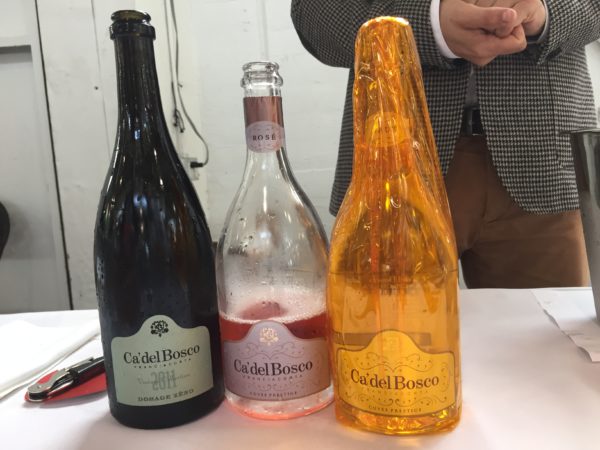
Ca’ del Bosco Brut Cuvée Prestige:
75% Chardonnay, 25% Pinot blanc. Made from 30% reserve wines, the Cuvée Prestige spends two years on the lees. It’s creamy with pineapple overtones. $36 to $40.00. 90 points.
Friuli is in a cul-de-sac northeast of Venice, tucked in between the mountains and the sea, and against the Slovenian border. The whites there are particularly fine.
Livio Feluga, 2015 Collio, Pinot Grigio:
A dry white with a lively fruit cocktail nose (grapes, citrus, pears), minerally, spicy and complex on a round palate. Among my favorite white wines in the world. $21.00. 92 points.
Livio Felgua’s 2013 Rosazzo Terre Alte is also very good, but at $70 it’s not a great value.
Colterenzio 2014 Alto Adige, Sauvignon Lafòa:
This honestly doesn’t taste much like Sauvignon Blanc, but it’s damn good. It sports super intense fruit of citrus, star fruit and kiwi. A consistently superior producer, though the $40 price point is on the high side for the U.S. market. 91 points.
Marche is just below Bologna and Venice on the Adriatic coast. There, steep mountains fall precipitously toward the sea, and from the flanks of the mountains and the foothills comes some of the most underrated wine from Italy. As a result it’s dirt cheap.
Velenosi 2014 Marche Offida, Pecorino Rêve:
The family name, Velenosi, means vipers. They make excellent reds and whites and their wine is not too difficult to find in the U.S. The Pecorino grape is an indigenous white Italian variety, and in this case Velenosi gave it the oddly French nickname of Rêve (dream). It’s a lovely, fruity wine hovering on the edge of off-dry, with an intriguing flavor profile of pear, apple and grapefruit, with an extremely long finish. Just $11.00. 91 points.
Velenosi 2012 Rosso Piceno Superiore, Roggo del Filare:
A blend of Montepulciano and Sangiovese grapes, this terrific red wine offers uplifting black plum, blackberry, vanilla and dark chocolate notes, with soft tannins and a rich finish. Terrific stuff. $30.00. 93 points.
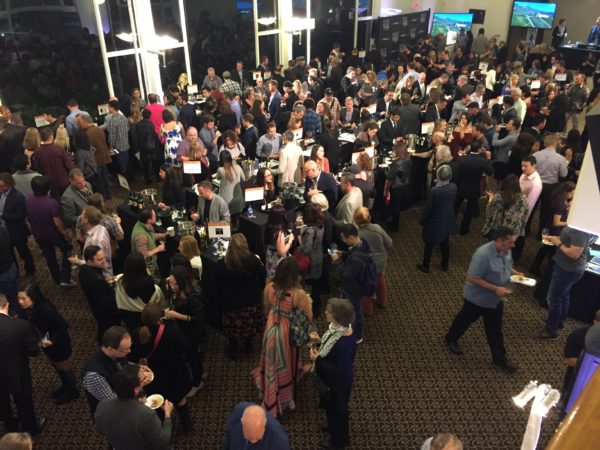
The second Italian tasting I attended recently was James Suckling’s Great Wines of Italy. Suckling had the great good fortune of being appointed to cover European wines for The Wine Spectator when the Spectator was just ramping up to expand internationally in the early 1980s. I commend James for his palate, and for putting up with publisher Marvin Shaken all those years. I’d tell you what I really think of Marvin, but I don’t want to be sued for libel. Let’s just say it was good James had an ocean between them. Anyway, I looked forward to this event, and the wines were among the very best I’ve ever seen in one place at one time. But it was horribly oversold. The crush was intolerable. The din impossible. The spit buckets too few. And there were loudspeakers blaring pop music to compete with the mingled voices of 3,000 people stuffed into three rooms. Nonetheless, dear reader, I was able to taste a few of these fabulous wines to share with you here. For the most part they aren’t cheap, but they are the best of the best.
Petra, 2013 Toscana, Hebo: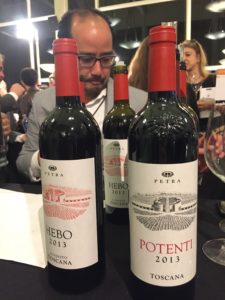
I begin with the best value wine I’ve had in ages. Petra is an interesting winery in the Maremma region of Tuscany on the Mediterranean coast. The winery was designed by the same architect who designed the Modern Art Museum in San Francisco, and the two structures share a common theme. While the SF Modern Art Museum is filled with shockingly inept art, bottles of Petra are filled with exquisitely complex wine. The 2013 Hebo is a blend of 50% Cabernet Sauvignon, 40% Merlot, and 10% Syrah. It displays terrific subtlety and persistence, with black currant, red currant and earthy undertones, with soft tannins and long finish. Good now. Better in another 5 to 7 years. $24.00. 98 points.
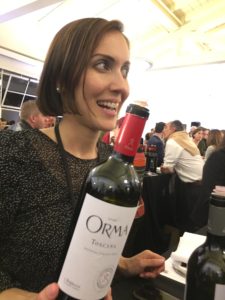 Orma, 2014 Toscana:
Orma, 2014 Toscana:
Vittorio Moretti, who looks like an older Cary Grant, also owns the above mentioned Petra, as well as Tenuta Sette Ponti below. Orma has a dense blackberry core, with undertones of earth and dark chocolate. It’s full bodied with silky tannins and classical structure. Beautiful constructed and holding the same level of intensity from the nose through the finish. $55.00. 98 points.
Tenuta Sette Ponti, 2014 Toscana, Oreno: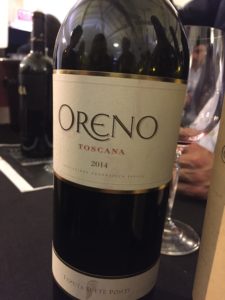
It’s hard to describe so perfect a wine. It’s spicy and bright, with vibrant intensity, lush blueberry and blackberry fruit, crisp acid, moderate tannin and a mouthwatering finish. Intense without being heavy-handed. Gorgeous wine for $60.00. 99 points.
Luce Della Vite, 2013 Toscana:
Blackberry, blueberry, chocolate and licorice combine in this great red, with soft tannins and an extremely long finish. Good stuff, if expensive. $100. 95 points.
Fontanafredda, 2010 Barolo Vigna la Rosa:
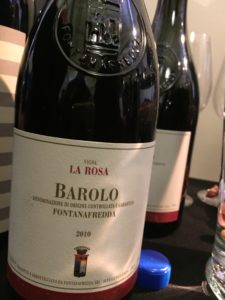 Complex aromas and flavors of rose petals, licorice, earth and strawberries. Moderate tannin. Lovely now and will improve over the next 10 years. $70.00. 97 points.
Complex aromas and flavors of rose petals, licorice, earth and strawberries. Moderate tannin. Lovely now and will improve over the next 10 years. $70.00. 97 points.
Poderi Gianni Gagliardo, 2013 Barolo, Castelletto:
Barolo, which is made from Nebbiolo grapes, usually starts out as hard and tannic, and only after 8 or 10 years does it become perfumed and rather Pinot Noir-like. This one, on the other hand, is a more delicate version from the get-go. It has aromatic rose petal and strawberry aromas, with gentle tannins (for a Barolo), medium body and a nuanced finish. Good now, it will only get better over the next 10 to 15 years. Not cheap, but very good. $80.00. 97 points.

Great list and descriptions! I’ll be looking for some of these. Thanks!